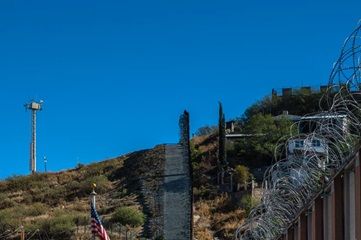If the US Department of Homeland Security (DHS) gets its way, Congress will grant it more than $107 billion to run its enforcement regime during the 2025 fiscal year. Buried in the lengthy budget request is $101 million to upgrade and maintain the network of surveillance towers scattered throughout the borderlands. According to its own official publications, Customs and Border Protection (CBP) hopes to fully integrate these systems through AI.
Politicians from both parties have long hailed CBP’s vast system, called the Integrated Surveillance Towers, as a sort of virtual wall that allows agents to better patrol the border. Although the surveillance towers comprise a small fraction of DHS’s gargantuan budget, funding for the system has been steadily growing for decades.
DHS expects the system to reach “full operational capacity” by 2034, at which point there will be more than 1,000 manned and unmanned towers along both of the US’s land borders. There’s still quite a ways to go. As of last week, there were an estimated 429 surveillance towers in the US-Mexico borderlands, according to the Electronic Frontier Foundation.
In official publications, the agency has described its expanded surveillance network as a means through which it will “bring badges back to the border.” The long-term goal is to create a “more autonomous” Border Patrol through artificial intelligence. CBP publications note that AI can be used to “identify relevant patterns in interactions with immigrant populations,” bolster surveillance operations, and “predict adversary movements.”
Last September, Defense Daily reported that DHS plans on acquiring 277 new towers that will surveil 53 different Border Patrol areas of operation, and to upgrade 191 existing surveillance towers. Three companies will supply the towers: Advanced Technology Systems, General Dynamics, and Elbit America, a subsidiary of the Israel-based Elbit Systems.
The $101 million DHS is asking for to fund the Integrated Surveillance Towers system in 2025 will largely go toward maintenance and repairs. The request notes that 10 of the existing Remote Video Surveillance System towers need to be upgraded, while 15 Integrated Fixed Towers need to have their obsolete radar systems replaced.
DHS has been working on the surveillance towers in fits and starts since 2005. Its initial attempt, billion-dollar Secure Border Initiative Network — SBInet for short — was such a failure it was scrapped in 2011. Customs and Border Protection awarded Elbit a $145 million contract in 2014 to build a new tower system, which is far more effective from a technological standpoint but has nonetheless failed to reduce border crossings








